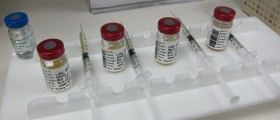
Penicillin allergic reaction is actually an overreaction of the immune system initiated by the intake of any penicillin based antibiotic. The allergic reaction to penicillin may be mild and occur in a form of rash or sometimes it can be quite severe in a form of a life-threatening anaphylaxis.
Penicillin allergy is reported as the most frequent of all allergies to medications. This is bad because penicillin antibiotics are very efficient against many bacteria.
Once the person is diagnosed with penicillin allergy, he/she must never be prescribed any antibiotic containing penicillin for the rest of his/her life. However, not all reactions after taking penicillin are allergic so before definitive confirmation of the allergy doctors must be completely sure that the reaction a person has experienced after taking the antibiotic is not perhaps, non-allergic in origin.
Symptoms of Penicillin Allergy
People allergic to penicillin typically experience hives, skin rash and itchy skin. There may also be breathing difficulties in a form of wheezing or swelling of the face, lips or tongue known as angioedema.
Anaphylactic reaction initiated by penicillin is rather severe and if left untreated, may cause lethal outcome. Breathing difficulties associated with wheezing, rapid and weak pulse, drop in blood pressure and accompanying dizziness, swelling of the throat and tongue as well as loss of consciousness all point to the presence of anaphylactic reaction.Penicillin Allergy Treatment Options
People allergic to penicillin must never use this type of antibiotic. This is the best prevention against the onset of the allergic reaction.
Treatment for penicillin allergic reaction basically depends on the type of reaction as well as symptoms and signs patients are dealing with. Skin rash and hives are not so problematic and may be dealt with antihistamines, or oral/injected corticosteroids.
The most complex treatment is for anaphylactic reaction when patients must be administer several drugs all of which reduce inflammatory reaction of the entire body and bring symptoms such as low blood pressure, breathing difficulties and throat swelling soon under control. Anaphylactic reaction requires an injection of epinephrine among other drugs such patients receive.
What needs to be mentioned is that some infections actually can be treated solely with penicillin. In that case one is first tested for penicillin allergic reaction. If sensitivity is confirmed, a person may need to undergo desensitization. Namely, patients are administered small and gradually increased doses of penicillin under surveillance of doctors. Desensitization generally takes place in a hospital. Desensitization is efficient only while patients are treated with penicillin. If the person will need to take penicillin again, he/she will undergo the entire process of sensitization once again.

















Your thoughts on this
Loading...